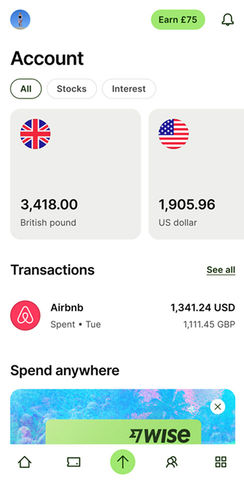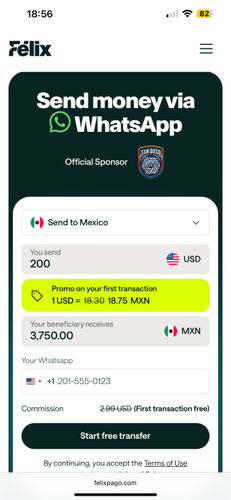Send money from United States to Colombia
"Over 16 million customers use Wise, mostly for their excellent mobile app, transparent fee structure & use of mid-market rates. Now increasingly used for larger transfers."
"Xe has over 30 years of currency exchange experience, and is one of the most reputable names on the market. 200 countries, 100 currencies, & funds often received in seconds."
"FelixPago ofrece transferencias rápidas, seguras y accesibles a Latinoamérica por WhatsApp, con retiro en efectivo por $4.99, combinando conveniencia, tarifas bajas y servicio confiable."
"Sendwave is trusted by over 1 million users across the US, UK, Canada and EU. 24/7 support is available online and via the app."
"Xe has over 30 years of currency exchange experience, and is one of the most reputable names on the market. 200 countries, 100 currencies, & funds often received in seconds."
"24/7 live chat support provided in six languages. Special first transfer rates available, with airtime topup supported to many countries in Africa, Asia and South America."
"Over 16 million customers use Wise, mostly for their excellent mobile app, transparent fee structure & use of mid-market rates. Now increasingly used for larger transfers."
"Remitly focuses on sending money to friends and family in Asia, Africa and South America. Wide coverage and well-suited to regular transfers home."
"Over 16 million customers use Wise, mostly for their excellent mobile app, transparent fee structure & use of mid-market rates. Now increasingly used for larger transfers."
"Xe has over 30 years of currency exchange experience, and is one of the most reputable names on the market. 200 countries, 100 currencies, & funds often received in seconds."
Best way to send: Wise
We tested & reviewed 12 money transfer companies offering services between the United States and Colombia, and Wise scored the best.
So for a great mix of cost, speed & features, make your United States to Colombia transfer using Wise.

Getting the best deal on your United States to Colombia transfer
Considerations for sending money from United States to Colombia
Compare providers
Always compare ways to send money from the United States to Colombia to get the best options for fees, speed, and reliability.
Our analysis included 12 providers that operate between United States and Colombia.
Through this, you get a comprehensive view of all the options you have in the United States when you need to send money to Colombia.
Track the US Dollar-Colombian Peso exchange rate
Choose the right payment method
Use regulated providers
Consider transfer limits
How to receive money in Colombia
Have your ID ready
Don't forget about taxes
Cheapest way to send money to Colombia from the United States: Felix
They offer a fee of 2.99* USD and exchange rate between USD-COP that is 0.33% different to the mid-market rate.
In comparison, Felix is 0.01% cheaper than the second-best option.
To secure affordable and great rates on a USD to Colombia transfer, Felix is our recommended choice.
*The most common fee applied to USD-COP by Felix, based on our data.

Fastest way to send money to Colombia from the United States: Wise
For urgent USD to COP money transfers, they’re our recommended choice.
A USD-Colombian Peso transfer through Wise comes with a 57.92 USD fee.
To ensure Wise was the 'fastest' option we compared 12 providers. This comparison was for overall speed of sending money from the United States to Colombia and is a combination of depositing US Dollar, transfer times to Colombia and withdrawal timeframes where applicable.
When speed is a priority, Wise is the top choice for sending into Colombia from the United States.

Need to make a large transfer?
Wise is the best option for large transfers of the 12 providers compared.
While Wise may not always be the cheapest or fastest way to send USD from the United States to Colombia, it's a great provider for larger transfers for things like buying or selling property.

Understanding the cost of transferring money from United States to Colombia
The total cost of money transfers from United States to Colombia is a combination of fees and exchange rates. Get the best of both, and you will be getting a good deal.
The Mid-Market and Exchange Rates: The mid-market rate for USD-COP is currently 3,748.38 COP per US Dollar. Providers offering services closer to this rate will ensure more Colombian Peso for your US Dollars.
To give a historic average, over the 7 days the USD-COP mid-market rate has been 3,770.9609 COP per US Dollar, this has had a high of 3,806.74 and a low of 3,736.38.
From the 12 companies compared, Wise offers the best exchange rate on transfers to Colombia and the United States.
Generally, the exchange rate you receive on converting USD to COP will be the biggest factor impacting the cost of sending US Dollars to Colombia.
Fees: Transfer fees are charged alongside a transfer. The company offering the lowest fee is Felix at a fee of 2.99 USD per transfer. In all cases, we recommend searching for your exact send amount as fees may change.
Amount Received: Money transfer companies will show you the amount eventually received in Colombian Peso. Simply, the higher the amount received in the United States, the lower the cost of sending from Colombia.

How to find the best exchange rate for US Dollar to Colombian Peso
Timing is essential for sending money between USD and COP. The exchange rate you secure impacts how much COP you get for your USD.
Let's dive into some interesting recent trends.
Over the past 7 days, the exchange rate from USD to COP has seen some fluctuation. On average, it stood at 3,770.9609.
During this period, the highest value recorded was 3,806.74, while the lowest was 3,736.38.
Wise, which is our recommended service to send money online from United States to Colombia offers an exchange rate that is only 0% above the mid-market rate.
Want to secure the best USD-Colombian Peso exchange rates?
Sign up for our rate alerts and we'll tell you when it's the best time to move your money from United States to Colombia!
United States to Colombia money transfer payment methods
How we analyze the market
We track the cost, speed, and product offerings of the leading money transfer services available between Colombia and United States.
Our comparison engine and algorithms evaluate providers based on over 25 factors, including transfer fees, ease of use, exchange rates, mobile apps, transfer times & customer support.
We also consider how these services are rated on platforms like TrustPilot, AppStore, and Google Play, giving you a comprehensive view of what to expect.
This thorough analysis helps you get the best available deal - every time you want to move money from United States to Colombia.
We also provide unbiased and detailed reviews of all the top money transfer companies. You can use these reviews to send USD to COP.
For a deeper understanding of our commitment to integrity and transparency, we invite you to read our editorial policy and review methodology.




.svg)































